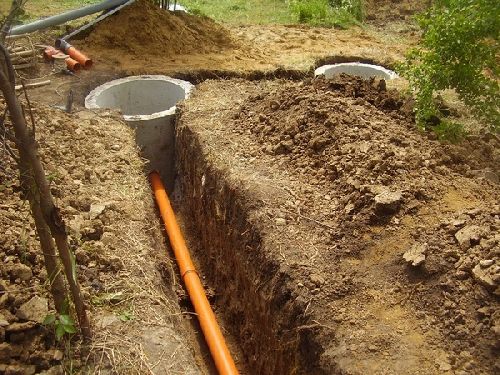When arranging local sewerage, many questions arise. And one of the most burning - to what depth to bury the sewer? Let's try to figure it out.
Modern people relate to life a little differently than it was accepted twenty or thirty years ago. If earlier in the country the arrangement of an outdoor toilet was considered quite normal, today few people want to sacrifice their usual amenities. Therefore, and, moreover, in a country cottage is simply necessary.
In the event that the owner has the opportunity to order the execution of all work on the sewerage device to professionals, questions, as a rule, do not arise. But if, for reasons of economy or for other reasons, a person far from construction undertakes the construction of a septic tank, then in order to avoid mistakes, he has to study a fairly large amount of information.
Before answering the question about the depth of the trench for, you need to figure out which pipes to use?
Pipes for local sewerage

Previously, only metal pipes were used for the construction of sewers. However, due to the susceptibility of metal to corrosion, it is increasingly being replaced by plastic.
An additional argument in favor of plastic pipes is that there is no need to resort to the services of a welder and involve construction equipment for laying, because plastic and metal pipes of the same diameter differ significantly in weight.
When choosing types of pipes for organization, it should be remembered that there are varieties for internal and external sewage.
- Internal sewerage devices include all plumbing items and pipelines located inside the house.
- External sewerage includes pipelines located on the street, as well as storage and treatment facilities for wastewater.
Pipes intended for outdoor use are produced in brown-orange, and those designed for use in the house are light gray.
Advice! Carefully read the information placed in the accompanying documents for the pipes. As a rule, manufacturers try to describe in detail the scope of each type of pipe. And do not forget to ask to familiarize yourself with the quality certificate to make sure that you are purchasing a worthwhile product, and not a fake.
At what depth should the sewer pipe exit from the house?

According to the requirements of SNiP, the outlet of the sewer pipe from the house should be located 30 cm above the average freezing depth, but at the same time, the laying depth should not be less than 70 cm. In practice (in the conditions of the middle lane), most often, the pipe is laid at a depth of 50 cm.
Such a depth is sufficient, provided that no roadway or platform is planned on the surface, which will be cleared of snow in winter.
What should be the slope of the pipe?
In most cases, when arranged, it is assumed that the drains will go by gravity, due to the slope of the pipe. What should this bias be?
In SNiN 2.04.01-85 it is indicated that when using pipes with a diameter of up to 50 mm, the slope is 0.03 meters per meter of pipeline. When using pipes up to 100 mm in diameter, this figure is 0.02 m.
If this condition is not met, the flow in the pipe will move either too rapidly or, conversely, too slowly. Both situations threaten to clog pipes, as solid waste will settle in them, interfering with the flow.
Is it necessary to lay sewer pipes below the freezing level?
Many non-specialists mistakenly believe that the depth of laying a pipeline for local sewage should exceed the freezing depth. In fact, this is not always possible.
To make it clear, let's look at a specific example. It is generally accepted that in the middle lane the soil freezes to a depth of 1.6 meters. The distance from the house to the first chamber of the septic tank is 15 meters, therefore, if a pipe with a diameter of 100 mm is used, it will be 30 cm.
Thus, according to our calculations, the entry point to the septic tank will be located at a depth of 1.9 meters (1.6 + 0.3 = 1.9). And if there is an increase in relief in the direction of the location of the treatment plant, then the difference in heights will also need to be taken into account.
Thus, if it was planned to arrange a septic tank of a standard depth of 2.7 meters (from three concrete rings of 0.9 m each), then with such a low entry point, its useful depth will be only 0.8 meters (2.7-1.9 = 0.8), which, of course, is insufficient.
That is, in order to achieve the planned usable volume, you will have to dig a pit already under five standard rings. And this is already quite a significant additional cost for materials and digging a pit. In addition, when deciding to build such a deep septic tank, one must also take into account such a circumstance as the level of groundwater.
Conclusion
In the conditions of the middle lane, it is quite enough that the depth of the trench for laying sewers near the house is 0.5 meters. Further, the pipes should go with the slope recommended by SNiP.
You don't have to worry about the sewers freezing up. Firstly, draining, as a rule, occurs with water at least at room temperature, so the frost that appears on the pipe walls is simply washed off.
Secondly, heat penetrates into the pipes, which is formed due to the biological processes occurring in the septic tank. At the same time, when the sewer system is not in use, the pipes are empty, so there is nothing to freeze there.


















